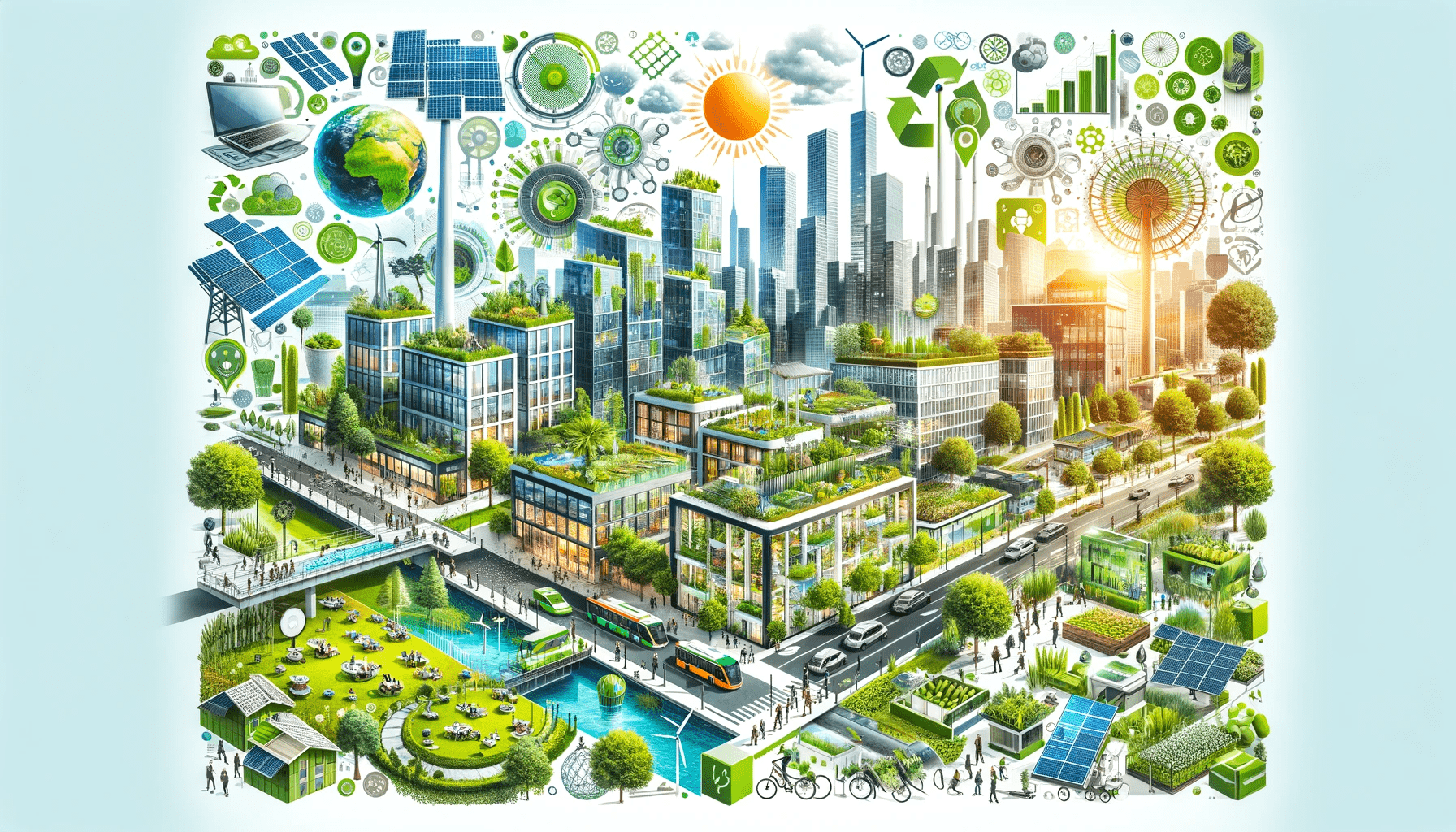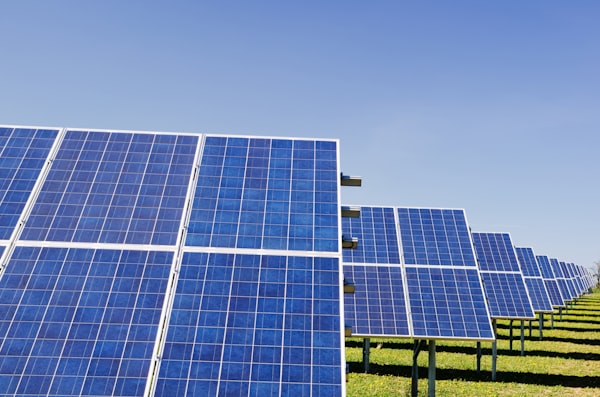Federal Grants for Green Infrastructure Projects
Get insights into the eligibility criteria for federal grants supporting green infrastructure projects in the U.S.

Green Industry Innovative Initiatives
- Greening America's Communities: This program by the US EPA has helped 37 communities with sustainable design strategies. The program provides design assistance to support sustainable communities that protect the environment, economy, and public health[1].
- C40's Green & Thriving NeighbourhoodsC40's Green & Thriving Neighbourhoods: C40 supports neighborhood pilot projects in cities around the globe, creating green and thriving neighborhoods that improve health and well-being.
- Sustainable Cities Integrated Approach Pilot (IAP-PROGRAM): This program promotes an approach to urban sustainability guided by evidence-based, multi-dimensional, and broadly inclusive planning processes[6].
- Pilot Cities Program: This program supports European cities to test and implement systemic and locally designed innovative approaches to rapid decarbonization[15].
Funding Sources
- Green Infrastructure Funding Opportunities: The US EPA lists federal funding sources and over 550 resources to support local water infrastructure projects, including stormwater/green infrastructure funding[3].
- Green Streets, Green Jobs, Green Towns (G3) Funding Opportunities: This program by the US EPA provides a list of other funding sources to help assist communities seeking to implement green streets[10].
- Green Infrastructure Toolkit: This toolkit provides information on how green infrastructure projects may be funded by federal programs that support efforts to reduce water pollution and manage stormwater[7].
- Pursuing Green Public Works Projects: This report discusses how pursuing green public works projects can help stimulate the economic climate and provide jobs to residents[11].
Case Studies and Examples
- Case Studies from Green Industry Platform: This platform provides case studies on global topics and allows users to create dedicated groups focused on specific themes, initiatives, projects, and communities[4].
- Pilot Projects from Metropolis: Metropolis generates spaces to explore the challenges of metropolization from a cross-sectoral approach through pilot projects[9].
- Companies with Great Environmental Initiatives: This article provides examples of companies that have shifted priorities by using business intelligence to save on costs and become environmentally aware[5].
- Top 10 Green Technology Innovations: This article lists the top 10 green technology innovations shaping our sustainable future, including advancements in renewable energy, water purification, and eco-friendly transportation options[14].
In your case study, you can provide a detailed analysis of these initiatives, funding sources, and examples and offer practical guidance on how city managers can implement similar projects in their communities.
Citations:
[1] https://www.epa.gov/smartgrowth/greening-americas-communities
[2] https://www.c40.org/news/green-thriving-neighbourhood-pilot-projects/
[3] https://www.epa.gov/green-infrastructure/green-infrastructure-funding-opportunities
[4] https://www.greenindustryplatform.org/case-studies
[5] https://www.smartcitiesdive.com/ex/sustainablecitiescollective/9-companies-great-environmental-initiatives/1193165/
[6] https://www.thegef.org/projects-operations/projects/9077
[7] https://www.georgetownclimate.org/adaptation/toolkits/green-infrastructure-toolkit/how-to-pay-for-green-infrastructure-funding-and-financing.html
[8] https://www.brookings.edu/articles/why-green-jobs-plans-matter-and-where-u-s-cities-stand-in-implementing-them/
[9] https://www.metropolis.org/pilot-projects
[10] https://www.epa.gov/G3/green-streets-green-jobs-green-towns-g3-funding-opportunities
[11] https://iop.harvard.edu/sites/default/files/2023-02/GreenPolicyPaper.pdf
[12] https://www.agenda21culture.net/our-cities/pilot-cities
[13] https://www.sbeap.org/funding-sources
[14] https://sustainablereview.com/top-10-green-technology-innovations/
[15] https://netzerocities.eu/pilot-cities-cohort-1-2022/
[16] https://www.energy.gov/funding-financing
[17] https://www.nyc.gov/office-of-the-mayor/news/274-23/mayor-adams-releases-planyc-getting-sustainability-done-new-york-city-s-strategic-climate-plan
[18] https://www.ntnu.edu/sustainability/pilot-projects
[19] https://meadhunt.com/green-infrastructure-8-solutions/
[20] https://www.sourgum.com/the-sour-scoop/us-green-industry-analysis/
[21] https://www.unhabitat.org.in/projects/sustainable-cities-integrated-approach-pilot-(sciap)
[22] https://www.energy.gov/infrastructure/clean-energy-infrastructure-funding-projects-and-programs
[23] https://greenroofs.org
[24] https://unhabitat.org/news/05-nov-2021/the-first-sdg-cities-conference-in-shanghai-announces-seven-pilot-projects
[25] https://www3.wipo.int/wipogreen/en/network/funding.html

There are several funding sources available for green infrastructure projects in the United States:
- Federal Funding: Various federal agencies provide funding for green infrastructure projects. These include the National Oceanic and Atmospheric Administration (NOAA), U.S. Department of Agriculture (USDA), U.S. Department of Defense (DOD), U.S. Department of Energy (DOE), and U.S. Department of Homeland Security (DHS)[1].
- Clean Water State Revolving Fund (CWSRF): This federal program provides grants for water infrastructure projects[2].
- USDA National Urban and Community Forestry Program: Under the U.S. Forest Service, this program provides cost-share grants to support urban and community forestry projects with national and multistate impact[1].
- USDA Rural Development Water and Environmental Programs (WEP): WEP is a federal source of funding for green infrastructure projects that can be used to help prevent localized flooding and erosion[1].
- Five Star and Urban Waters Restoration Grant Program: The US Environmental Protection Agency program seeks to develop community stewardship to restore and sustain local natural resources and wildlife habitats[1].
- Transportation Infrastructure Finance and Innovation Act (TIFIA): This program targets transportation projects incorporating green elements. State and local governments and private entities can apply for low-interest loans to fund these projects[7].
- USDA Rural Development Water and Environmental Program: This program supports water and waste management projects in rural areas. Rural communities can access loans, grants, and guarantees to implement green infrastructure solutions for sustainable water management[7].
- Federal Emergency Management Agency (FEMA) Hazard Mitigation Grant Program (HMGP): This program provides post-disaster federal aid to states for projects like soil stabilization that can be part of green infrastructure[5].
- U.S. Department of Transportation (DOT): Green infrastructure projects are often eligible for transportation funding because they improve efficiency and safety[5].
- Infrastructure Investment and Jobs Act (IIJA) and the Infrastructure and Reconciliation Act (IRA): These laws have allocated $1.25 trillion for infrastructure projects across the country, including green workforce development[8].
Remember, the availability of these funds can vary, and it's essential to check the specific requirements and application processes for each funding source.
Citations:
[1] https://www.epa.gov/green-infrastructure/green-infrastructure-funding-opportunities
[2] https://www.georgetownclimate.org/adaptation/toolkits/green-infrastructure-toolkit/how-to-pay-for-green-infrastructure-funding-and-financing.html
[3] https://www.sbeap.org/funding-sources
[4] https://www.epa.gov/sites/default/files/2017-05/documents/federal-and-california-sw-funding-programs_0.pdf
[5] https://meadhunt.com/green-infrastructure-8-solutions/
[6] https://www.georgetownclimate.org/adaptation/toolkits/green-infrastructure-toolkit/federal-funding.html
[7] https://www.planetizen.com/blogs/127023-future-federal-funding-green-city-initiatives
[8] https://www.brookings.edu/articles/unlocking-new-federal-infrastructure-funding-to-drive-green-workforce-development/

Local governments can apply for federal grants to fund green infrastructure projects through several programs. Here's a step-by-step guide based on the search results:
- Identify Relevant Federal Programs: Several federal programs fund green infrastructure projects. These include the EPA Water Infrastructure Finance and Innovation Act (WIFIA), the USDA National Urban and Community Forestry Program, the Five Star and Urban Waters Restoration Grant Program, and the FEMA Hazard Mitigation Grant Program[1][4][6].
- Understand the Eligibility Criteria: Each program has its eligibility criteria. For example, the WIFIA program provides loans for water infrastructure projects. At the same time, the Five Star and Urban Waters Restoration Grant Program seeks to develop community capacity for diverse local wetland, riparian, forest, and coastal restoration and wildlife conservation[1].
- Prepare a Strong Application: Federal grants can be highly competitive. It's essential to demonstrate the benefits of your green infrastructure project, such as how it can prevent localized flooding and erosion, improve public well-being, and create resilient ecosystems[1][2][3].
- Leverage Multiple Funding Sources: Green infrastructure projects can generate many benefits, allowing them to compete for diverse funding sources. Consider combining multiple funding and revenue sources or pairing a funding source with a financing mechanism[6].
- Apply for the Grant: Once you've identified a suitable program and prepared your application, you can submit it according to the program's application process. This typically involves submitting an online application form along with any required supporting documents[1][2][3].
Remember, the availability of these funds can vary, and it's essential to check the specific requirements and application processes for each funding source. It's also beneficial to seek advice from experts or consultants who are familiar with the application process for federal grants[1][2][3].
Citations:
[1] https://www.epa.gov/green-infrastructure/green-infrastructure-funding-opportunities
[2] https://www.georgetownclimate.org/adaptation/toolkits/green-infrastructure-toolkit/how-to-pay-for-green-infrastructure-funding-and-financing.html
[3] https://www.georgetownclimate.org/adaptation/toolkits/green-infrastructure-toolkit/federal-funding.html
[4] https://dec.ny.gov/environmental-protection/water/water-quality/nps-program/funding-programs
[5] https://www.sbeap.org/funding-sources
[6] https://meadhunt.com/green-infrastructure-8-solutions/
The eligibility requirements for applying for federal grants for green infrastructure projects in the United States vary depending on the specific program. However, some common requirements across different programs include:
- Applicant Eligibility: The applicant must often be a local government, state agency, tribal entity, or non-profit organization. For example, the EPA's Section 319 Nonpoint Source Management Program and the USDA's Rural Energy for America Program accept applications from these entities[2][3].
- Project Eligibility: The project must align with the grant program's goals. For instance, the EPA's Five Star and Urban Waters Restoration Grant Program seeks projects that develop community capacity for diverse local wetland, riparian, forest, and coastal restoration and wildlife conservation[1]. The USDA's Rural Energy for America Program requires projects to be a Renewable Energy System (RES) or RES retrofit that produces zero greenhouse gas emissions[3].
- Matching Funds: Some programs require applicants to provide matching funds. For example, the USDA's Rural Energy for America Program requires applicants to provide matching funds if applying for a grant only[3].
- Technical Merit and Commercial Availability: The USDA's Rural Energy for America Program requires all projects to have technical merit and utilize commercially available technology[3].
- Environmental Review: Some programs, like the USDA's Rural Energy for America Program, require an environmental review before award or construction[3].
- FEMA's Building Resilient Infrastructure and Communities (BRIC) Program: This program offers an increased cost share, 90% federal share for Economically Disadvantaged Rural Communities, and 100% management costs for all[4].
Remember, these are general guidelines, and the requirements can vary depending on the grant program. It's essential to review the specific eligibility requirements for each grant program before applying[1][2][3][4].
Citations:
[1] https://www.epa.gov/green-infrastructure/green-infrastructure-funding-opportunities
[2] https://www.epa.gov/G3/green-streets-green-jobs-green-towns-g3-funding-opportunities
[3] https://www.rd.usda.gov/programs-services/energy-programs/rural-energy-america-program-renewable-energy-systems-energy-efficiency-improvement-guaranteed-loans
[4] https://www.fema.gov/grants/mitigation/building-resilient-infrastructure-communities
[5] https://www.georgetownclimate.org/adaptation/toolkits/green-infrastructure-toolkit/how-to-pay-for-green-infrastructure-funding-and-financing.html
[6] https://www.epa.gov/system/files/documents/2021-11/navigating-federal-funding_green-infrastructure_508.pdf
[7] https://www.rd.usda.gov/inflation-reduction-act/rural-energy-america-program-reap
[8] https://www.fema.gov/grants/mitigation/building-resilient-infrastructure-communities/after-apply/fy22-status
[9] https://www.epa.gov/sites/default/files/2017-05/documents/federal-and-california-sw-funding-programs_0.pdf
[10] https://www.epa.gov/nps/using-low-impact-development-and-green-infrastructure-get-benefits-fema-programs
[11] https://www.usda.gov/topics/farming/grants-and-loans
[12] https://www.epa.gov/sites/default/files/2016-04/documents/epa-lid-gi_and_hma_final.pdf
[13] https://www.georgetownclimate.org/adaptation/toolkits/green-infrastructure-toolkit/federal-funding.html
[14] https://epa.illinois.gov/topics/grants-loans/water-financial-assistance/gigo.html
[15] https://www.rd.usda.gov/media/file/download/reap-renewable-energy-systems-faqs.pdf
[16] https://www.fema.gov/grants/mitigation/hazard-mitigation/before-you-apply
[17] https://www.sbeap.org/funding-sources
[18] https://www.epa.gov/cwsrf/green-project-reserve-guidance-clean-water-state-revolving-fund-cwsrf
[19] https://www.usda.gov/sites/default/files/documents/uaip-frequently-asked-questions-fy2022.pdf
[20] https://www.caloes.ca.gov/office-of-the-director/operations/recovery-directorate/hazard-mitigation/prepare-california/
[21] https://casaweb.org/resources/funding-opportunities/
[22] https://www.usda.gov/sites/default/files/documents/fy22-uaip-presentation.pdf
[23] https://www.adaptationclearinghouse.org/resources/fema-hazard-mitigation-grant-program.html
[24] https://meadhunt.com/green-infrastructure-8-solutions/
[25] https://www.rd.usda.gov/programs-services/water-environmental-programsguides




